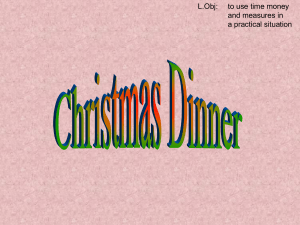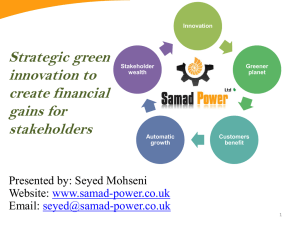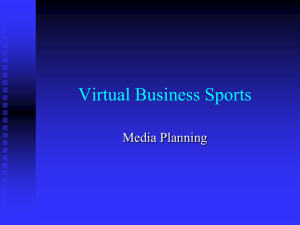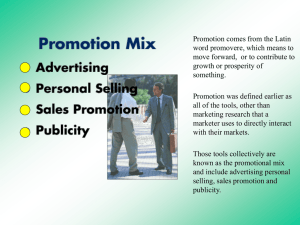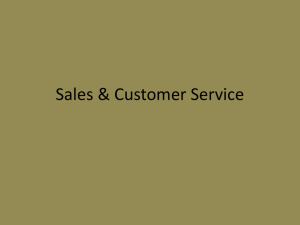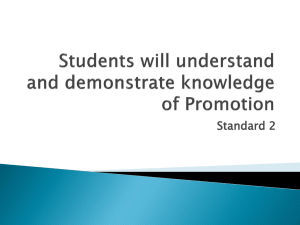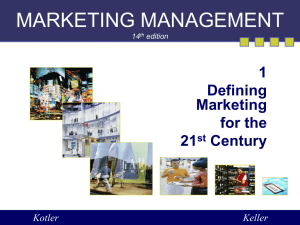Module 8
advertisement
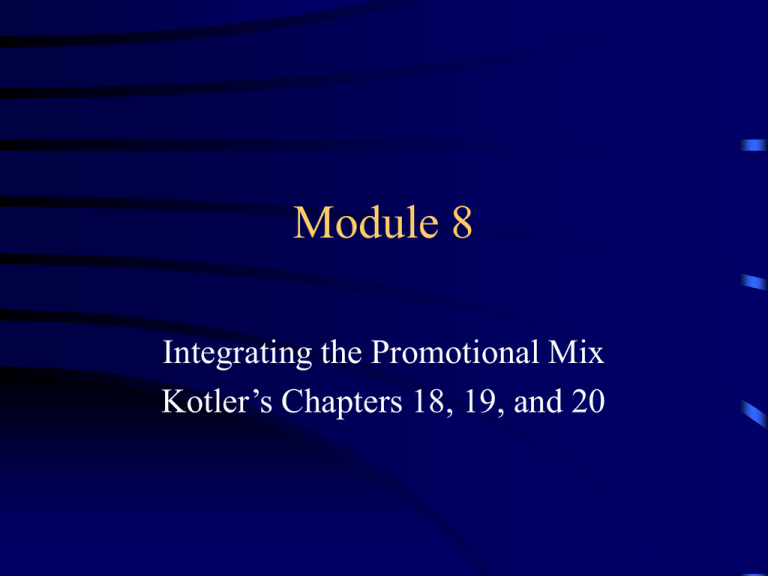
Module 8 Integrating the Promotional Mix Kotler’s Chapters 18, 19, and 20 Chapter 18: Managing Integrated Marketing Communications • Learning Objectives • 1. Describe the elements in the communication process. • 2. Discuss and apply the eight steps in developing effective communications. • 3. Describe and apply the promotional tools and the factors involved in determining the communication mix. Chp 18/Obj 1: Describe the elements in the communication process. • Marketers need to consider all brand contact as a communication opportunity. Figure 18-1 (p. 551). • 2 major parties: sender and receiver. • 2 major communication tools: message and media. • 4 major communication functions: encoding, decoding, response, and feedback. The encoding and decoding process must mesh. • 1 problem element – noise of random and competing messages that can interfere with intended communication. Chp 18/Obj 1: Describe the elements in the communication process. • 3 reasons why target audience may not get the message intended (deal with perceptions). – 1. Selective Attention – people bombarded by messages (estimated 1600 commercial messages a day with only 80 noticed) – 2. Selective Distortion – people hear what fits in with their belief system. – 3. Selective Retention – only a small amount of communication makes it to LT memory. Chp 18/Obj 2: Discuss and apply the eight steps in developing effective communications. • 5 Elements of Marketing Communications • 1. Advertising – paid form of nonpersonal communication by an identified sponsor • 2. Sales Promotion – ST incentives to encourage trial or purchase • 3. Public Relations and Publicity – nonpaid communication to promote an image or product • 4. Personal Selling – face-to-face interaction with a prospect for the purpose of making presentation, answering questions, and making a sale • 5. Direct Marketing – use of mail, phone, fax, e-mail or Internet to communicate directly with/solicit a direct response from customers. Chp 18/Obj 2: Discuss and apply the eight steps in developing effective communications • • • • • • • • 1. Identify target audience 2. Determine communication objectives 3. Design the message 4. Select the communication channel 5. Establish the total communications budget 6. Decide on communications mix 7. Measure the communications’ result 8. Manage the integrated marketing communication process Chp 18/Obj 2: Discuss and apply the eight steps in developing effective communications • 1. Identify target audience – Need a clear idea of target market as this influences what, how, when, where, and to whom to say it. – Image analysis - determining familiarity, favorability along key dimensions is valuable. • 2. Determine communication objectives – Cognitive (think- awareness and knowledge) – Affective (feel – liking preference, and conviction) – Behavioral (do - purchase); Hierachy of effects model. Chp 18/Obj 2: Discuss and apply the eight steps in developing effective communications • 3. Design the message – what to say, how to say it logically, how to say it symbolically, and who should say it – Message Content – rational, emotional, moral – Message Structure – 1sided (strongest argument first) vs. 2sided (strongest argument last) – Message Format – everything must help make the central point from the font chosen to the voice used – Message Source- credibility comes from expertise, trustworthiness, and likeability Chp 18/Obj 2: Discuss and apply the eight steps in developing effective communications • 4. Select the communication channel – Personal Communication Channels – advocate (salespeople), expert (independent), social channels (ex. friends, word-of-mouth key) – Nonpersonal Communication Channels – media (ex. newspapers), atmosphere (ex. packaged environment), and events (ex. grand openings) • 5. Establish total communications budget – Best method is Objective and Task (determine objectives and then what will cost to meet it) Chp 18/Obj 2: Discuss and apply the eight steps in developing effective communications • 6. Decide on communications mix – Advertising, Sales Promotion, PR/Publicity, Personal Selling, or Direct Marketing • 7. Measure the communications’ result – What impact did firm make on target audience? Were the objectives met? Chp 18/Obj 2: Discuss and apply the eight steps in developing effective communications • 8. Manage the integrated marketing communication process (IMC) – IMC – a concept of marketing communications planning that recognizes the added value of a comprehensive plan that evaluates the strategic roles of a variety of communications disciplines and combines these to provide clarity, consistency, and maximum communications’ impact through the seamless intergation of discrete messages (i.e make sure everyone on the same page and working together). – Firms need a consistent, coordinated plan for dealing with a fragmented, complicated, sophisticated marketplace. Chp 18/Obj 3: Describe and apply the promotional tools and the factors involved in determining the communication mix • There are five promotional tools that Marketers can combine to meet their objectives. Each of these tools have its own unique characteristics and costs. – 1. Advertising – ex. Banner ads • Advertising works in the long term to build an image for a product. It is a non-personal public presentation that allows a firm to amplify/dramatize their message to persuade consumers. It aids in reaching a geographically dispersed audience. May not have an impact in the short run and hard to gauge consumers’ reaction due to impersonal nature of ads. Chp 18/Obj 3: Describe and apply the promotional tools and the factors involved in determining the communication mix • 2. Sales Promotion – ex. Coupons – Works in the short-term to get a quick response from the buyer. Can help with communication and provides an incentive or invitation to buy now. May hurt image in LR as train consumers to buy on deal. • 3. Public Relations/Publicity – ex. Release – Is more credible than ads and can catch buyers off guard (is it part of the news rather than a commercial) and can dramatize a firm/product. Control though may be an issue (may be negative). Chp 18/Obj 3: Describe and apply the promotional tools and the factors involved in determining the communication mix • 4. Personal Selling – May be most effective tool at later stages of the buying process (ex. conviction). Involves an immediate and interactive response that can develop into a relationship with the buyer. Expensive and must be done well. • 5. Direct Marketing – includes direct mail, telemarketing, Internet marketing – Is nonpublic, customized, up-to-date, and interactive. The better the database, the better the results - an opt-in database may have better response rates than opt-out. Chp 18/Obj 3: Describe and apply the promotional tools and the factors involved in determining the communication mix • Factors in setting the communication mix – Type of Product Market • Consumer marketers spend most on sales promotion and advertising, while business marketers spend most on personal selling and sales promotion. – Push versus Pull Strategy • Push focuses on trade while pull focuses on final consumer. – Buyer-Readiness Stage and Product-Life Cycle Stage • Advertising and PR most important in awareness building. Personal Selling can help with comprehension, conviction and closing the sale. Sales promotion can help close the sale. – Company Market Rank – advertising more effective for market leaders while sales promotion may work best for smaller competitors. Chapter 19: Managing Advertising, Sales Promotion, Public Relations • Learning Objectives • 1. Discuss and apply the five major decisions involved in developing and managing an advertising program. • 2. Describe the purpose and decisions involved with sales promotion and public relations. Chp 19/Obj 1: Discuss and apply the five major decisions involved in developing and managing an advertising program. • 1. Setting the advertising objective - needs to be specific and definable – If target market unaware - need to inform – If target aware - need to persuade – If target already customers - need to remind • 2. Deciding on the advertising budget – Amount needed depends on stages in PLC, current market share levels, competition and clutter, advertising frequency needed, and product substitutability. Chp 19/Obj 1: Discuss and apply the five major decisions involved in developing and managing an advertising program. • 3. Choosing the advertising message – Message generation • Develop a number of approaches to communicate a key benefit; costly to generate lots of approaches – Message evaluation and selection - what to say • Focus on one strong selling proposition - research which approach works best to convey that – Message execution - how to say it; style, tone, words, format • Everything in ad must fit together; creativity needed – Social responsibility review - not illegal or offensive Chp 19/Obj 1: Discuss and apply the five major decisions involved in developing and managing an advertising program. • 4. Choosing the media - determine how many exposures needed, what media is most cost-effective – Reach - # exposed to ad at least once – Frequency - # of times that person exposed to ad (need at least 3, some suggest need 5-9 exposures) – Impact - qualitative value of an exposure – Choosing among major media types (see 19-1, p. 588) – Selecting specific vehicles - what media does target use – Deciding on media timing - when and how often – Deciding on geographical allocation - national or local Chp 19/Obj 1: Discuss and apply the five major decisions involved in developing and managing an advertising program. • 5. Evaluating advertising effectiveness – Communication effectiveness - copy testing • Variety of means to pre and post test how message interpreted; measure recognition, recall, physiological reactions – Sales effectiveness • Analyze historical and experimental sales data in an effort to pinpoint the impact of different levels of advertising expenditures. Chp 19/Obj 2: Describe the purpose and decisions involved with sales promotion and public relations • Sales Promotion - offer an incentive to buy – Purpose - focus on trade, then consumer • Use it to build relationships with suppliers and improve their performance, to motivate and improve performance of sales force, and to stimulate trial of their product. – Major Decisions • Establishing objectives; Selecting consumer, trade, and business-sales force tools (Tables 19.3, 19.4, 19.5); Develop the Program (budget, size of incentive, conditions for participation, duration of the program, distribution vehicle, and timing of the program); Pre-test Program; Implement /control program; and Evaluate results. Chp 19/Obj 2: Describe the purpose and decisions involved with sales promotion and public relations • Public Relations - promote/protect image – Purpose - proactive and reactive • PR departments proactively develop ways to improve the image of the firm, build relationships, and promote specific products. Also help firm react when faced with negative publicity or requests for information. – Major Decisions • • • • Establish the marketing objectives Choose messages and vehicles - get media coverage Implement the plan Evaluate results in terms of exposures, impact and sales. Chapter 20: Managing the Sales Force • Learning Objectives • 1. Describe and apply the issues involved in designing and managing the sales force. • 2. Describe the principles of personal selling. Be sure to include the major steps in selling. Chp 20/Obj 1: Describe and apply the issues involved in designing and managing the sales force • Step 1-3 deal with designing sales force • 1. Determine sales force objectives/strategy – Activities include prospecting, targeting time, communicating, selling, servicing, information gathering (research) and/or allocating products. – Options include sales rep, sales team, conference selling and seminar selling. Can be direct (inside and field) or contractual (ex. manufacturers’ rep) • 2. Determine sales force structure – Territorial, product, market, and complex – Which structure best depends on market, environment. Chp 20/Obj 1: Describe and apply the issues involved in designing and managing the sales force • 3. Determine sales force size/compensation – Determine number of reps needed by dividing the total number of annual calls needed for the all clients divided by the average number of calls a rep can make annually – Compensation needs to address how to utilize fixed, variable, expense allowance, and benefit components. • Steps 4-8 deal with managing sales force Chp 20/Obj 1: Describe and apply the issues involved in designing and managing the sales force • 4. Recruit and select sales reps – 20% turnover on average. Sales rep must have empathy and ego drive. • 5. Train sales reps – Need to know company (products, systems, objectives), customers, competitors, how to make effective sales presentations, and field procedures and responsibilities. • 6. Supervise sales reps – Set performance norms and goals. – Provide support in terms of guidance, motivation, information technology, and time management. Chp 20/Obj 1: Describe and apply the issues involved in designing and managing the sales force • 7. Motivate sales reps – Being a sales rep is a tough job. – Sales quotas tied to compensation. – Supplementary motivators such as sales meetings, contests, bonuses, and rewards • 8. Evaluate sales reps – Need to determine source of information and how will do a formal evaluation. Must be fair and consistent, rep shouldn’t be surprised. Chp 20/Obj 2: Describe the principles of personal selling. Be sure to include the major steps in selling. • Professionalism - Salespeople must know how to transform prospects into customers, to identify customer needs and to produce effective solutions. • Negotiation - Can negotiate only when a zone of agreement exists between buyer and seller (i.e. range of outcomes in which both parties benefit). Need to formulate a negotiation strategy. • Relationship Marketing - Build LT profitable relationships that emphasize problem solving and win/win. Have to focus on customer and their needs. Chp 20/Obj 2: Describe the principles of personal selling. Be sure to include the major steps in selling. • • • • 1. 2. 3. 4. Prospecting and qualifying - good leads Preapproach - learn about prospect Approach - get off to a good start Presentation and demonstration – Best to get customer talking, work to solve their problems. • 5. Overcoming objections - psychological and logical • 6. Closing - size up situation, assess customer and determine best method to get customer to take the final step • 7. Follow up and maintenance - LT relationship Module 8 Conclusion • Effective communication with customers is key. But this communication must be carefully planned and coordinated in order to serve its purpose (meet objectives). • There are five key communication tools in the promotional mix: advertising, sales promotion, personal selling, public relations, and direct marketing. Firms need to determine how to use and combine these to meet their objectives given their internal and external environment. • Firms need to focus on how promotion can help build LT relationships with customers. Promotion can be too expensive if it is always aimed at finding new buyers. • Any questions?

